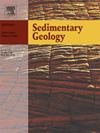From Platform to Burial: Tectonic and climatic imprints on the diagenetic evolution of shallow-marine carbonate deposits (Middle Eocene), Bombay Offshore Basin, India
IF 2.9
2区 地球科学
Q1 GEOLOGY
引用次数: 0
Abstract
Conventional cores collected from a shallow tropical carbonate-ramp system reflect a diagenetic pathway that was influenced by both the globally humid, tropical climate at the middle Eocene time and the subsequent onset of Himalayan mountain building. Detailed optical, cathodoluminescence-petrographic and non-isotopic geochemical analyses were used for the study. The eogenetic processes, e.g., micritization, pyritization, isopachous and micritic cementation, early marine dolomitization, and the early stages of mechanical compaction, happened during and soon after deposition in the marine-phreatic environment. During the late Eocene, as the global climate cooled, the relative sea level fell, and the carbonate ramp underwent subaerial exposure, leading to the meteoric-phreatic diagenetic processes, e.g., neomorphism, dissolution (phase-1), pendant cementation (vadose zone), and significant calcite spar cementation (C-1). With ensuing deposition above through the early Oligocene, the effects of compaction affected the formation by truncation and fragmentation of grains, condensed packing, developing various (point-tangential, concavo-convex, and sutured) grain contacts, pressure dissolution and stylolite generation, fracturing, corrosion (phase-2 dissolution), and burial-calcitic (C-2) and non-calcitic (NC) cementation. After the early Oligocene, the basin tilted westward, a far-field consequence of the Indo-Eurasian collision. This tectonic reorganisation caused the Paleogene carbonate strata to undergo a partial exhumation and thus, they were susceptible to the influence of meteoric water mainly through the reactivation of pre-existing faults. These tectonic readjustments led to the reopening of the stylolite sets, telogenetic fracturing, and another dissolution episode (phase 3). Hence, the diagenetic pathway manifesting itself at the microscopic scale posits a clear connection with the basin's evolution. Further, the diagenetic reconstruction also corroborates the global climatic transition, from a greenhouse to a cooler ice-house condition, that took place across the Eocene-Oligocene boundary, making the study significant from a regional to global scale.
从台地到埋藏:印度孟买近海盆地中始新世浅海碳酸盐沉积成岩演化的构造和气候印记
从热带浅层碳酸盐岩斜坡系统采集的常规岩心反映了始新世中期全球湿润的热带气候和随后开始的喜马拉雅造山运动共同影响的成岩路径。采用详细的光学、阴极发光、岩石学和非同位素地球化学分析进行了研究。泥晶化、黄铁矿化、等泥晶和泥晶胶结、早期海相白云石化和早期机械压实作用等成岩作用发生在沉积期间和沉积后不久。始新世晚期,随着全球气候变冷,相对海平面下降,碳酸盐斜坡经历了地面暴露,形成了新形态、溶蚀(第1阶段)、悬垂胶结(气相带)和显著的方解石晶石胶结(C-1阶段)等大气-呼吸成岩作用。在渐新世早期的沉积过程中,压实作用影响了颗粒的截断和破碎、压缩堆积、各种(点切、凹凸和缝合)颗粒接触、压力溶解和茎柱石生成、压裂、腐蚀(第2阶段溶解)以及埋藏-钙化(C-2)和非钙化(NC)胶结作用。早渐新世以后,盆地向西倾斜,这是印度-欧亚碰撞的远场结果。这种构造重组使古近系碳酸盐岩地层经历了部分挖掘,因此,它们容易受到大气水的影响,主要是通过原有断层的再激活。这些构造调整导致了柱化岩组的重新开放、远生断裂和另一个溶蚀期(第3阶段)。因此,在微观尺度上表现出来的成岩路径与盆地演化有着明确的联系。此外,成岩重建也证实了全球气候的转变,从温室到较冷的冰窖条件,发生在始新世-渐新世边界,使研究从区域到全球范围内都具有重要意义。
本文章由计算机程序翻译,如有差异,请以英文原文为准。
求助全文
约1分钟内获得全文
求助全文
来源期刊

Sedimentary Geology
地学-地质学
CiteScore
5.10
自引率
7.10%
发文量
133
审稿时长
32 days
期刊介绍:
Sedimentary Geology is a journal that rapidly publishes high quality, original research and review papers that cover all aspects of sediments and sedimentary rocks at all spatial and temporal scales. Submitted papers must make a significant contribution to the field of study and must place the research in a broad context, so that it is of interest to the diverse, international readership of the journal. Papers that are largely descriptive in nature, of limited scope or local geographical significance, or based on limited data will not be considered for publication.
 求助内容:
求助内容: 应助结果提醒方式:
应助结果提醒方式:


